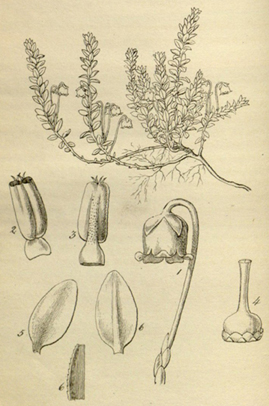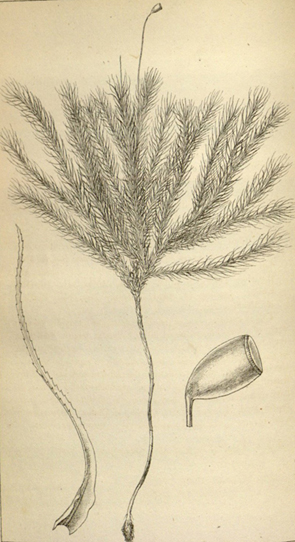[Tab. IX] [1837, vol. 1]
Tab. IX

Allan & Ferguson bithey
Pernettia pumila.
[TAB. IX]
TAB. IX.
PERNETTIA PUMILA.
Humilis, caulibus procumbentibus, foliis ovatis obtusis supra convexis subtus carinatis marginibus subtilissime cartilagineocrenulatis.
Arbutus pumila. Linn. Suppl. p. 239. Forst. Comment. Goett. 9. p. 32. Willd. Sp. Pl. v. 2. p. 619.
HAB. South part of Terra del Fuego (n. 171), at an elevation of 2000 feet:—Cape Tres Montes, Lat. 47°. W. Patagonia. C. Darwin, Esq., Dec. 1834 (n. 503).
Gaudichaud, who established the genus Pernettia in the Annales des Sciences Naturelles, at first confidently referred the Arbutus pumila, Linn., to his Pernettia empetrifolia from the Falkland Islands; but afterwards, in the "Voyage," introduced it as a synonym, with a mark of interrogation: and I think it will be found that the description of Linnæus better accords with that which I here figure from Terra del Fuego and Cape Tres Montes. Freycinet's plant is very much larger, a single branch being represented 9 or 10 inches high, nor do the leaves appear to have the minutely crenated cartilaginous margin which is so remarkable in our plant.
Fig. 1. Peduncle and flower. f. 2, 3. Front and back view of an anther. f. 4. Pistil. f. 5. Front, and f. 6. Back view of a leaf, magnified. f. 7. Portion of the margin of a leaf, highly magnified.
[TAB. XVI] [1837, vol. 1]
DONATIA MAGELLANICA.
Donatia fascicularis. Forst. Gen. t. 5.
Donatia Magellanica. Lam. Ill. t. 51. De Cand. Prodr. v. 4. p. 53.
Polycarpon Magellanicum. Linn. Suppl. p. 115.
HAB. Chonos Archipelago. Dec. 1834. C. Darwin, Esq. (n. 57).
A rare and very interesting little antarctic plant, remarkable for the varied number of the different parts of its flower. The stems are scarcely 2 inches in height. The leaves are numerous and densely imbricated, linear, hairy in the axils. Flowers sessile, solitary. Germen turbinate, incorporated with the tube of the calyx, bearing a small subulate bractea, and 4 minute, remote, subulate calycine segments. Petals apparently on the same series with the calycine segments, in the plant I examined 8 in number. Stamens 9. Styles 3. Cells of the ovary 3. Ovules several, suspended from the top of the cell.
Fig. 1. Plants: nat. size. f. 2. Flower. f. 3. Do. From which the petals are removed. f 4. Vertical section of the germen. f. 5. Back, and f. 6, Front view of a leaf:—magnified.
[Tab. XXV] [1837, vol. 1]
Tab. XXV

Allan & Ferguson bithey
[POLYTRICHUM DENDROIDES]
TAB. XXV.
POLYTRICHUM DENDROIDES
Elatum comosum, foliis elongates lineari-subulatis serratis siccitate tortilibus, seta terminali (vel ob innovationibus laterali), capsula pyriform-ovali terete inclinata exapophysata.
Polytrichum dendroides. Hedw. sp. Musc. Suppl. I. 2. p. 346. II. 2. p. 2. t. 151. f.1. Brid. Musc. Rec. II P. 1. p. 101. t. 5. f. 6.
HAB. First found in the Straits of Magellan by Commerson. South part of Terra del Fuego. C. Darwin, Esq. (n. 465). On the highest maritime mountains between Valdivia and the river Toltea, S. Chili. Mr. Reynolds (n. 41). Island of Chiloe. Cuming (n. 1441). Dusky Bay, New Zealand. A. Menzies, Esq.
This is certainly one of the finest species of a very fine Genus; some of my specimens being full 9 inches in length. All bear their branches at the extremity of the stem in a singularly tufted or dendroid manner. The fruit seems to be especially rare: of the two authors who have figured the plant, neither had seen the fructification; and amongst all the specimens that I possess, or have examined, not one had a capsule but that which is here represented, gathered by Mr. Cuming in Chiloe; nor was there a calyptra or operculum, which are yet unknown to authors.
Fig. 1. Leaf. f. 2. Capsule: - magnified.
[TAB. CXXXVII] [1837, vol. 2]
TAB. XXV
HAMADRYAS ANDICOLA.
Sericea, acaulis foliis rhombeo-ovatis integris integerrimis junioribus petalis calycibusque subtus basique petioli sericeo-villosissimis.
HAB. Lofty and very cold situations upon the Cordillera of Andimarca, Peru. Mathews, (n. 1139).
I think there can be no doubt of this being a genuine Hamadryas, judging from the figure of H. Magellanica in De Lessert's lcones, and from a specimen in our Herbarium collected by Mr. Darwin: but my specimens of the present species are not sufficiently copious to allow of my examining so minutely as I could wish, the structure of the flowers, nor do they possess any fruit, which is still a desideratum among Botanists. It differs essentially from the species just mentioned as well as from H. tomentosa, not only in the entire leaves, but also in the absence of a stem. The centre of our little plant from which the flower rises, is clothed with very long beautifully silky hairs.
[TAB. DCLXXII] [1844, vol. 7]
BERBERIS DARWINII. Hook.
Ramis junioribus rufo-pubescentibus, spinis brevibus palmatopartitis, foliis ridige conriaceis nitidis discloribus cuneatis apice trifidis margine paucidentatis dentibus lobisque spinulosis, racemis folio longioribus, pedicellis flores duplo superantibus gracilibus, baccis (una cum stylo persis tente) lageniformibus.
HAB. Chiloe, C. Darwin, Esq. Valdivia and Osorno, Bridges n. 582, 585.
There is no difficulty in characterizing this well-marked species. The leaves are very constant to their form, sessile, but tapering more or less at their base, very rigid, glossy, especially above, pale and often rusty-coloured beneath. Peduncles twice or thrice the length of the leaves, reddish, as are the long slender pedicels, each of which has an ovate, concave scale or bractea at the base. Berries, probably not quite mature, almost black, with a glaucous tinge, shaped like a flask, the style and stigma representing the neck and head of the flask.
Fig. 1. Flower. f. 2 Back view of ditto. f. 3. Petal and stamen. f. 4 Pistil:- magnified.
[TAB. DCLXXIV] [1844, vol. 7]
CALLIXENE POLYPHYLLA. Hook.
Elata valde ramosa, foliis copiosis oblongis subovatisve mucronulatis 5-7 nerviis transversimque (sub lente) venosis subtus glaucis, pedunculis folium fere æquantibus seu eo longioribus infra medium articulatis unibracteatis, petalis acutis maculatis, antheris incumbentibus.
HAB. S. Chili. Trunks of trees near Valdivia, where it is called "Asajur," Bridges, n. 679. Cape Tres Montes, C. Darwin, Esq. n. 531-8. Isle of Huaffo, Dr. Eights.
Our larger specimens of this Callixene indicate a truly beautiful plant; they are a foot and a half long (and yet only a portion of the entire plant) with copious foliage, numerous large and probably fragrant flowers, white, it would appear, spotted with orange. It is extremely different from the old C. marginata of the Falkland Islands and Cape Horn, and equally so from that of New Zealand, C. parviflora, of this Work, TAB. DCXXXII. Besides the greater size, copious ramifications and leaves, these latter are glaucous beneath, and quite destitute of the silvery lines so conspicuous in the otl1er species, especially in C. marginata; the flowers are larger, the peduncles longer, the petals elegantly spotted. In the size and spotting of the flowers, this plant exhibits a still nearer affinity with the Luzuriaga radicans, R. and P.; a genus scarcely distinct from the present, except in the anthers being fixed to tl1e apex of the short filament by their base, and not versatile, and in the peduncles being 3-flowered. All the species of the genus have distichous leaves, and Dr. Hooker found them growing frequently at the roots of the trees in Tierra del Fuego, lying flat upon the trunk. The present, from Mr. Bridges' remark, would appear to be an epiphyte.
Fig. 1. lower. f. 2. Ditto, more expanded. f. 3, 4. Stamens. f. 5, Pistil. f. 6, Section of the ovary : -magnified.
[TAB. DCCLIII] [1844, vol. 7]
MELHANIA LEPRIEURII, Webb.
Caule fruticoso erecto ramoso, foliis ovalibus rotundisve serratis utrinque velutinis junioribus approximatis brevipetiolatis, floribus axillaribus terminalibusve brevissime pedunculatis solitariis rarius geminatis, involucelli triphylli unilateralis foliolis linearibus, staminibus 10.15, capsula globosa brevi villosissima. Guill. et Perr.
Melhania Leprieurii. Webb, Spicil. Gorgon. in Hook. Niger Voy. p. 110. Tab. IV, V.
Brotera Leprieurii. Guillem. et Perr. Fl. Sen. Tent. p. 85.
HAB. St. Jago, one of the Cape de Verd Islands, Darwin, J. D. H. Specimens from the same country are also in the Paris Museum.
Mr. Webb., I. c. has shown that Melhania and Brotera are one and the same; and further that the present species is perhaps too closely allied to M. velutina, Försk., or the M. incana, Heyne, and that it very much resembles M. ovata.
Fig. 1. Unexpanded flower. f. 2. Ditto, with sepals expanded:-magnified.
[TAB. DCCLXII] [1844, vol. 7]
CAMPANULA (MEDIUM) JACOBÆA, Chr. Sm
Fruticulosa, caule noduloso lignescente cavo, ramis difusis albidis junioribus fuscis strioso-hirtis foliosis, foliis spathulsto-ovalibus lanceolato-ovatis obtusiusculis strigosohirtis subtus pallidis nervosis basi attenuates caulinis breviter petiolatis sperioribus semi-amplexicaulibus, calycis tubo brevi cyathiformi laciniis anguste lanceolatis strigosociliatis, corolla campanulate æquali laciniis 3-plo longiore, filamentis plano-filiformibus basi dilatates glaberrimis, capsula depresssa, seminibus ovatis. Webb.
Campanula Jacobæa. Chr. Sm. in Tuck. Voy. p. 251. Webb, Spicil. Gorgon. in Hook. Nig. Voy. p. 148 Tab. XII.
HAB. Clefts of rocks, on mountains, at an elevation of 1500 to 2000 feet, Forbes, Darwin, Vogel. J. D. H.
This varies with the flowers blue or white. Webb.
Fig. 1. Stamen. f. 2. Pistil:- magnified.
[title page]
ICONES PLANTARUM;
OR
FIGURES,
WITH
BRIEF DESCRIPTIVE CHARACTERS AND REMARKS,
OF
NEW OR RARE PLANTS,
SELECTED FROM THE AUTHOR'S HERBARIUM.
BY SIR WILLIAM JACKSON HOOKER, K.H.,
LL. D., F.R.A. AND L.S.,
MEMBER OF THE IMP. ACAD. NAT. CUR. &c., &c., &c.,
HONORARY MEMBER OF THE ROYAL IRISH ACADEMY, OF THE ROYAL MEDICAL AND
CHIRURGICAL SOC. OF LONDON, &c., &c.
AND
REGIUS PROFESSOR OF BOTANY IN THE UNIVERSITY OF GLASGOW.